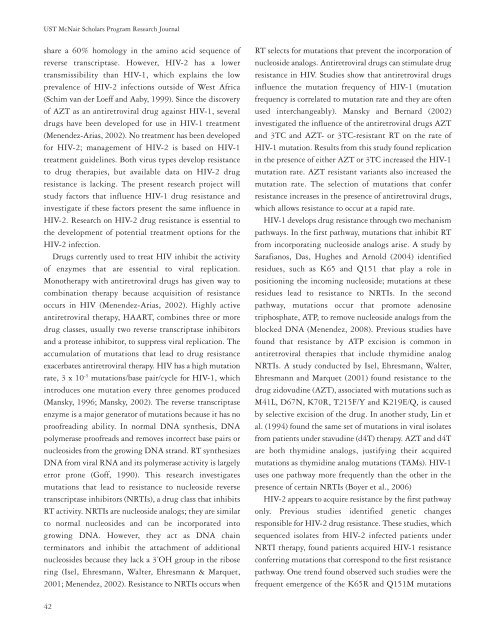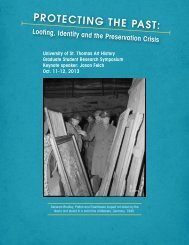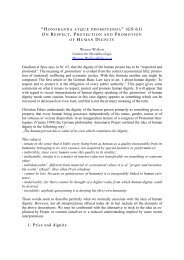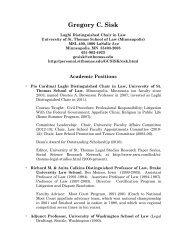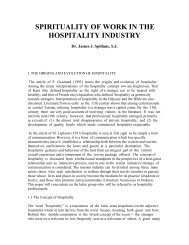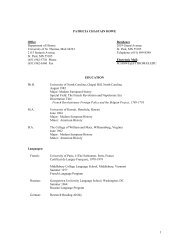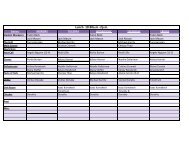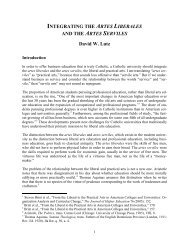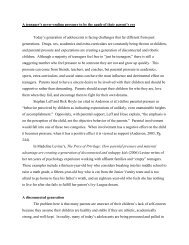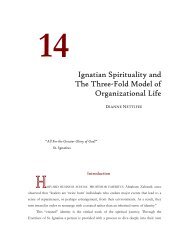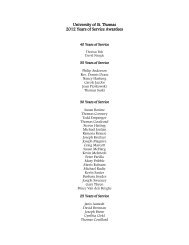dr. ronald e. mcnair acknowledgements - University of St. Thomas
dr. ronald e. mcnair acknowledgements - University of St. Thomas
dr. ronald e. mcnair acknowledgements - University of St. Thomas
You also want an ePaper? Increase the reach of your titles
YUMPU automatically turns print PDFs into web optimized ePapers that Google loves.
UST McNair Scholars Program Research Journal<br />
share a 60% homology in the amino acid sequence <strong>of</strong><br />
reverse transcriptase. However, HIV-2 has a lower<br />
transmissibility than HIV-1, which explains the low<br />
prevalence <strong>of</strong> HIV-2 infections outside <strong>of</strong> West Africa<br />
(Schim van der Loeff and Aaby, 1999). Since the discovery<br />
<strong>of</strong> AZT as an antiretroviral <strong>dr</strong>ug against HIV-1, several<br />
<strong>dr</strong>ugs have been developed for use in HIV-1 treatment<br />
(Menendez-Arias, 2002). No treatment has been developed<br />
for HIV-2; management <strong>of</strong> HIV-2 is based on HIV-1<br />
treatment guidelines. Both virus types develop resistance<br />
to <strong>dr</strong>ug therapies, but available data on HIV-2 <strong>dr</strong>ug<br />
resistance is lacking. The present research project will<br />
study factors that influence HIV-1 <strong>dr</strong>ug resistance and<br />
investigate if these factors present the same influence in<br />
HIV-2. Research on HIV-2 <strong>dr</strong>ug resistance is essential to<br />
the development <strong>of</strong> potential treatment options for the<br />
HIV-2 infection.<br />
Drugs currently used to treat HIV inhibit the activity<br />
<strong>of</strong> enzymes that are essential to viral replication.<br />
Monotherapy with antiretroviral <strong>dr</strong>ugs has given way to<br />
combination therapy because acquisition <strong>of</strong> resistance<br />
occurs in HIV (Menendez-Arias, 2002). Highly active<br />
antiretroviral therapy, HAART, combines three or more<br />
<strong>dr</strong>ug classes, usually two reverse transcriptase inhibitors<br />
and a protease inhibitor, to suppress viral replication. The<br />
accumulation <strong>of</strong> mutations that lead to <strong>dr</strong>ug resistance<br />
exacerbates antiretroviral therapy. HIV has a high mutation<br />
rate, 3 x 10 -5 mutations/base pair/cycle for HIV-1, which<br />
introduces one mutation every three genomes produced<br />
(Mansky, 1996; Mansky, 2002). The reverse transcriptase<br />
enzyme is a major generator <strong>of</strong> mutations because it has no<br />
pro<strong>of</strong>reading ability. In normal DNA synthesis, DNA<br />
polymerase pro<strong>of</strong>reads and removes incorrect base pairs or<br />
nucleosides from the growing DNA strand. RT synthesizes<br />
DNA from viral RNA and its polymerase activity is largely<br />
error prone (G<strong>of</strong>f, 1990). This research investigates<br />
mutations that lead to resistance to nucleoside reverse<br />
transcriptase inhibitors (NRTIs), a <strong>dr</strong>ug class that inhibits<br />
RT activity. NRTIs are nucleoside analogs; they are similar<br />
to normal nucleosides and can be incorporated into<br />
growing DNA. However, they act as DNA chain<br />
terminators and inhibit the attachment <strong>of</strong> additional<br />
nucleosides because they lack a 3’OH group in the ribose<br />
ring (Isel, Ehresmann, Walter, Ehresmann & Marquet,<br />
2001; Menendez, 2002). Resistance to NRTIs occurs when<br />
42<br />
RT selects for mutations that prevent the incorporation <strong>of</strong><br />
nucleoside analogs. Antiretroviral <strong>dr</strong>ugs can stimulate <strong>dr</strong>ug<br />
resistance in HIV. <strong>St</strong>udies show that antiretroviral <strong>dr</strong>ugs<br />
influence the mutation frequency <strong>of</strong> HIV-1 (mutation<br />
frequency is correlated to mutation rate and they are <strong>of</strong>ten<br />
used interchangeably). Mansky and Bernard (2002)<br />
investigated the influence <strong>of</strong> the antiretroviral <strong>dr</strong>ugs AZT<br />
and 3TC and AZT- or 3TC-resistant RT on the rate <strong>of</strong><br />
HIV-1 mutation. Results from this study found replication<br />
in the presence <strong>of</strong> either AZT or 3TC increased the HIV-1<br />
mutation rate. AZT resistant variants also increased the<br />
mutation rate. The selection <strong>of</strong> mutations that confer<br />
resistance increases in the presence <strong>of</strong> antiretroviral <strong>dr</strong>ugs,<br />
which allows resistance to occur at a rapid rate.<br />
HIV-1 develops <strong>dr</strong>ug resistance through two mechanism<br />
pathways. In the first pathway, mutations that inhibit RT<br />
from incorporating nucleoside analogs arise. A study by<br />
Sarafianos, Das, Hughes and Arnold (2004) identified<br />
residues, such as K65 and Q151 that play a role in<br />
positioning the incoming nucleoside; mutations at these<br />
residues lead to resistance to NRTIs. In the second<br />
pathway, mutations occur that promote adenosine<br />
triphosphate, ATP, to remove nucleoside analogs from the<br />
blocked DNA (Menendez, 2008). Previous studies have<br />
found that resistance by ATP excision is common in<br />
antiretroviral therapies that include thymidine analog<br />
NRTIs. A study conducted by Isel, Ehresmann, Walter,<br />
Ehresmann and Marquet (2001) found resistance to the<br />
<strong>dr</strong>ug zidovudine (AZT), associated with mutations such as<br />
M41L, D67N, K70R, T215F/Y and K219E/Q, is caused<br />
by selective excision <strong>of</strong> the <strong>dr</strong>ug. In another study, Lin et<br />
al. (1994) found the same set <strong>of</strong> mutations in viral isolates<br />
from patients under stavudine (d4T) therapy. AZT and d4T<br />
are both thymidine analogs, justifying their acquired<br />
mutations as thymidine analog mutations (TAMs). HIV-1<br />
uses one pathway more frequently than the other in the<br />
presence <strong>of</strong> certain NRTIs (Boyer et al., 2006)<br />
HIV-2 appears to acquire resistance by the first pathway<br />
only. Previous studies identified genetic changes<br />
responsible for HIV-2 <strong>dr</strong>ug resistance. These studies, which<br />
sequenced isolates from HIV-2 infected patients under<br />
NRTI therapy, found patients acquired HIV-1 resistance<br />
conferring mutations that correspond to the first resistance<br />
pathway. One trend found observed such studies were the<br />
frequent emergence <strong>of</strong> the K65R and Q151M mutations


